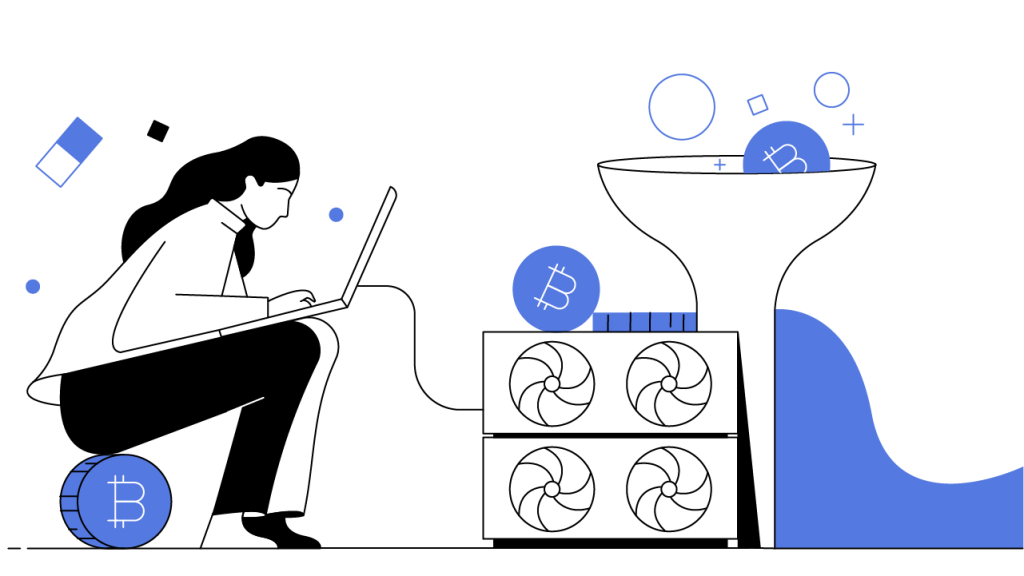Contents
Crypto Mining at Home vs. Industrial-Scale operations
From a single computer to a warehouse filled with hardware, crypto mining operations have evolved and vary in efficiency and scale.
Updated September 19, 2023 • 4 min read

Summary
Crypto mining operations come in all sizes: from home PCs to warehouses filled with thousands of the most technologically advanced and efficient mining rigs. Crypto miners generally fall into two camps: Retail miners who mine crypto from home, and large industrial-scale mining operations that are run by companies, corporations, or high-net-worth individuals (HNWIs).
What is Crypto Mining? Why is crypto mining important?
Crypto mining is the process by which transactions on a proof-of-work blockchain network are verified and added to the public ledger, known as the blockchain. Miners use powerful computers to solve complex mathematical puzzles, and when they successfully solve these puzzles, they validate and record transactions on the blockchain to earn mining rewards. This process is a fundamental component of blockchain technology and serves several purposes:
1. Transaction Verification
Miners ensure the validity of transactions by confirming that the sender has the necessary funds and that the transaction has not been altered.
2. Security
Mining adds new blocks of transactions to the blockchain, making it difficult for anyone to manipulate past transactions or create fraudulent ones. It secures the network against attacks.
3. Decentralization
Mining helps maintain the decentralized nature of blockchain networks, as miners are distributed worldwide and work independently to validate transactions.
4. Incentives
Miners are rewarded with cryptocurrency tokens for their efforts. This incentivizes them to participate in the network and contribute their computational power.
In summary, crypto mining is a crucial component of many blockchain networks, ensuring their security, immutability, and decentralization while also providing a means for miners to earn rewards for their participation.
Types of Crypto Mining Operations
Maintaining a global, decentralized network of nodes is key to any Proof-of-Work (PoW) based blockchain. These miners contribute computer hardware to the process of verifying transactions on the network and are rewarded in the native currency of the network for their efforts. The miners that make up any blockchain network, however, vary widely in scale and scope — from home crypto mining setups to large-scale, industrial mining operations. Similarly, there is a spectrum of crypto mining hardware (known as rigs) that ranges from personal computers to purpose-built mining hardware. The hardware used has various levels of hashing power and energy efficiency, which can factor into the degree of crypto mining profitability.
In general, crypto mining operations can be broken down into retail miners and industrial mining operations. Retail mining is generally done at home, typically as a hobby or side hustle. It can be for fun, profit, or a combination of both. From being revenue negative to making thousands of dollars a year, crypto mining profitability and overall success can vary based on your setup, experience, and adaptability, as well as on other factors beyond your direct control — such as the price you pay for electricity per kilowatt/hour (kWh).
Crypto Mining Warehouses and Large Crypto Mining Operations
While a retail miner may mine in the basement of their house, industrial-scale crypto mining operations tend to use a dedicated warehouse. Foregoing CPU and GPU miners, the vast majority of commercial crypto mining operations use hundreds — or even thousands — of the most powerful and efficient ASIC miners. Through efficiency, scale, and business savvy, these crypto mining farms can profitably compete to mine some of the coins that feature the most mining competition.
Crypto mining setups are differentiated by various hardware options, including: central processing units (CPUs), graphics processing units (GPUs), field-programmable gate arrays (FPGAs), or application-specific integrated circuits (ASICs). Unlike the more familiar and accessible CPUs and GPUs — which are more widely used by retail users mining crypto at home — FPGAs and ASICs have various performance characteristics that tend to make them better at mining most coins found on PoW blockchains. Thus, FPGA and ASIC miners tend to be large-scale, industrial mining endeavors.
ASIC miners can work very fast, but are generally not as adaptable as GPU and FPGA miners. The largest crypto mining operations tend to use ASIC bitcoin miners, which are only optimized to mine bitcoin (BTC) and other coins on blockchains that use the same hashing algorithm (SHA-256), such as bitcoin cash (BCH) and bitcoin satoshi vision (BSV). For example, ASIC bitcoin miners wouldn’t be great for the Scrypt hashing algorithm of Dogecoin (DOGE) or the X11 hashing algorithm of Dash (DASH).
Crypto Mining Sites in Cold Climates
While retail miners may endure a higher electricity bill for their home hardware setups, dealing with the heat generated by crypto miners is a real problem for larger crypto mining operations. Many of these mining farms use large industrial fans to keep the miners from overheating. Some of the newer ASICs are even liquid-cooled, although they still may need supplemental fan cooling.
For this reason, many of the most efficient industrial-scale operations are located in cold climates such as those found in Canada, Russia, Iceland, Kazakhstan, and northern parts of the U.S. Perhaps even more advantageously, many crypto mining farms located in these countries often benefit from cheaper-than-average electricity costs as well, further minimizing their mining costs. Due to these factors, many farms exist — and are continuing to be built — in these locations to maximize their return on investment (ROI).
Scalability, Logistics, and Colocation Options for Crypto Mining Farms
Many of the largest crypto mining operations use multiple warehouses to house their entire operation — some of which use up to 3,000 ASIC miners concurrently. An undertaking of such a size requires significant logistical considerations. Some large-scale mining operations leverage pre-existing industrial infrastructure, while others build and scale their warehousing footprint incrementally (for example, building or acquiring multiple new warehouses over time). This modularity can help the operation to be more easily and efficiently scaled up or down based on market conditions. In addition, this allows the mining operation to be relocated in order to adapt to better conditions.
For retail users looking to mine crypto on a large scale, colocation mining solutions allow aspiring miners to set up ASIC miners on-site at a colocation space. These services provide the infrastructure for your mining operations — for a price — and typically include the warehousing, powering, cooling, and even maintenance of units. This can be a good option for those who want to mine on a large scale, but don’t necessarily have the capital for their own personal mining operation location.
While crypto miners are generally divided into two camps (retail and industrial), they exist on a spectrum with some overlap. Some retail miners continue to scale until their profits approach or exceed what they make at their day jobs, with some eventually transitioning to doing it full time. Other industrial mining operations can support a company and pay salaries, but may use a colocation service if they don’t have the requisite investment capital for their own mining site. Like crypto investing, crypto mining doesn’t come with any guaranteed returns. Even some of the largest crypto mining operations may not be profitable due to the highly competitive nature of the sector and dynamic shifts in the crypto market.
Cryptopedia does not guarantee the reliability of the Site content and shall not be held liable for any errors, omissions, or inaccuracies. The opinions and views expressed in any Cryptopedia article are solely those of the author(s) and do not reflect the opinions of Gemini or its management. The information provided on the Site is for informational purposes only, and it does not constitute an endorsement of any of the products and services discussed or investment, financial, or trading advice. A qualified professional should be consulted prior to making financial decisions. Please visit our Cryptopedia Site Policy to learn more.

Is this article helpful?


